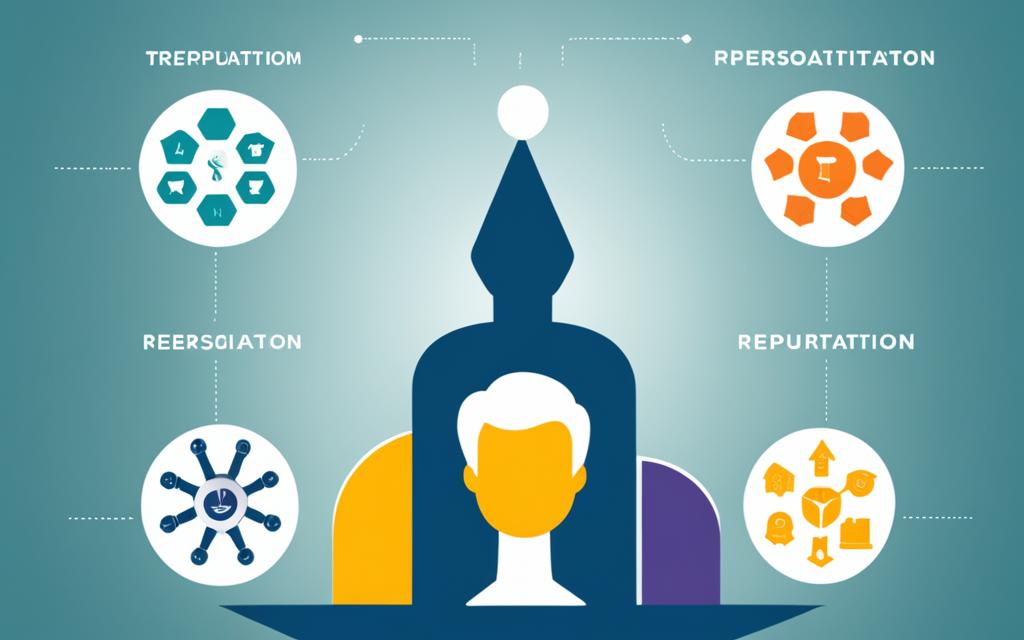In the unforgiving world of doing business in 2024, your personal reputation can be a delicate and fragile thing. Brand reputations are not just hard-fought and earned, but shockingly easy to see damaged – often at a moment’s notice and by anyone in possession of a smartphone and an axe to grind. For high-profile individuals, the stakes are highest; a single (perceived) public misstep can give rise to intense scrutiny, investor distrust, and customer loyalty downsides.
However, there is hope. Corporations across industries have shown an uncanny ability to not only weather reputational storms, but emerge from challenges even stronger than before. This article will explore how personal reputation management can help you, as an individual, overcome a crisis and rebuild your image through effective strategies to restore your good name.
Key Takeaways
- Personal reputation is fragile in the digital age, but can be repaired through strategic management
- Corporations have shown the ability to weather and emerge stronger from reputational crises
- Effective personal reputation management strategies can help individuals restore their good name
- Understanding the reputation landscape and quantifying damage is the first step
- Separating emotion from facts and setting realistic goals are crucial for effective reputation repair
Understanding the Reputational Risk Landscape
As a business leader, you understand the profound impact a company’s reputation can have. Firms with strong positive reputations attract top talent, are perceived as offering greater value, and often command premium pricing. Their customers exhibit more loyalty and purchase a wider range of products and services. However, most organizations struggle to effectively manage the risks to their reputations. Instead of proactively addressing these threats, they typically focus on mitigating the damage once a crisis has already surfaced.
The Reputation-Reality Gap
In today’s economy, where 70-80% of market value stems from intangible assets like brand equity and goodwill, companies are increasingly vulnerable to anything that harms their reputations. The gap between perception and reality can be a major source of reputational risk. Even well-managed firms can face challenges if their public image diverges from the operational realities.
Changing Beliefs and Expectations
Another key factor is the evolving nature of consumer beliefs and expectations. Factors like social media, environmental, social, and governance (ESG) concerns, and heightened transparency can rapidly shift public sentiment, creating new reputational risks for businesses. Staying ahead of these changing dynamics requires a proactive approach to reputation management strategies and personal branding.
| Statistic | Insight |
|---|---|
| Airmic members report reputational risk as their number one ‘keep’s me awake at night issue’ and a high concern for executive management and the Board. | Reputational risk is a top priority for businesses, requiring strategic attention from leadership. |
| Only a third of Airmic members have a high degree of confidence in how their firms manage reputational risk. | Most organizations struggle to effectively manage reputational risks, indicating a need for improved brand reputation management strategies. |
| Three-quarters of Airmic members plan to develop an approach to reputational risk management in the next 12 to 18 months. | Businesses are recognizing the importance of proactive personal image repair and are seeking to enhance their reputational risk management practices. |

By understanding the evolving reputational risk landscape, organizations can take a more proactive approach to safeguarding their personal branding and navigating the challenges of the digital age. Embracing reputation management strategies and staying attuned to changing consumer beliefs and expectations is crucial for maintaining a competitive edge.
Assessing and Quantifying Reputation Damage
When it comes to online reputation management, understanding the impact of digital and traditional media is crucial. The rise of social media has transformed the way individuals and organizations are perceived, with a single tweet or post potentially causing significant reputational harm. Social media crisis management has become a critical component of public relations crisis management strategies.
Digital Impact: Social Media and Online Presence
In today’s digital landscape, an individual’s online presence can make or break their reputation. Industry studies have indicated that 70% to 80% of market value comes from hard-to-assess intangible assets such as brand equity, intellectual capital, and goodwill, making organizations particularly susceptible to reputation damage. A positive online reputation is now the #1 most important factor for consumers when considering whether or not to frequent a business, with 97% of people looking online to learn more about a company in 2022.
Negative news has up to three times larger effect on reputation than positive news, and 90% of consumers do not visit a business with a bad reputation. Additionally, 87% of customers reverse a purchase decision after reading negative news or reviews online, while a single negative article can lead to a loss of up to 22% of prospective customers, increasing up to 70% with four or more negative articles.
Traditional Media and Public Perception
While social media has become a dominant force in shaping public perception, traditional media outlets still play a significant role in reputation management. In fact, 86% of Americans get their news online, and 79% of consumers trust online reviews as much as personal recommendations from friends or family. This underscores the importance of a comprehensive media relations strategy in effectively managing an individual’s or organization’s reputation.
Companies with strong positive reputations are noted to have higher price-earnings multiples and market values and lower costs of capital, indicating the financial impact of reputation on the bottom line. Executives recognize the significance of reputation management as it influences the quality of talent attracted, customer loyalty, and the range of products and services purchased.
| Reputation Metric | Impact |
|---|---|
| Price-earnings multiple | Higher |
| Market value | Higher |
| Cost of capital | Lower |
| Talent attraction | Improved |
| Customer loyalty | Increased |
| Product/service sales | Expanded |
Strategies for Personal Reputation Management
When it comes to managing your personal brand, setting realistic goals and expectations is crucial. Understanding the gravity of public perception and the reality of your situation is the foundation for charting a path forward. Whether it’s determining the feasibility of returning to your previous industry or deciding on the appropriate social media strategy, you must be honest with yourself about what’s genuinely achievable.
Setting Realistic Goals and Expectations
Rebuilding your reputation after a crisis is no easy feat. It requires a careful assessment of the damage and a clear understanding of the tools at your disposal. Reputation Return can help you navigate this process, utilizing legal, administrative, financial, and PR resources to gauge your sense of reality and set attainable goals.
Separating Emotion from Facts
A reputation crisis is a deeply personal ordeal, and it’s understandable to feel vulnerable and emotional. However, it’s essential to focus on the facts and separate them from the feelings. This involves examining what actually happened, the choices you made in response, and rebuilding your career plan by emphasizing your successes and downplaying your shortcomings. With the help of professionals, you can regain control and take proactive steps towards personal brand recovery and reputation rehabilitation.

Remember, effective reputation risk management is not just about addressing the current crisis; it’s about developing a long-term strategy to protect and enhance your personal reputation restoration. By setting realistic goals, managing your emotions, and leveraging the right tools and resources, you can navigate the challenge and emerge stronger than ever before.
The Role of Media in Reputation Repair
When it comes to managing your personal reputation during a crisis, understanding the power of media, both traditional and digital, is crucial. Deciding whether to proactively issue a statement, craft a message, and choose the right person to make the statement is just the beginning. The real challenge lies in navigating the pre-work and after-effects of communicating with the media.
In some situations, it may be best to pull away from the public eye, allowing the dust to settle before re-engaging. However, in other cases, connecting with a trusted journalist to help tell your story can be an effective strategy. Social media also requires a carefully planned approach, as engaging in public battles can exacerbate the situation and permanently etch the conflict in the public realm.
The media landscape has evolved significantly, with the rise of digital platforms and the increasing influence of social media. As of April 2023, there were 5.19 billion people online, equating to roughly 65% of the global population. Nearly 93% of online experiences start with a search engine, with search engines accounting for over 50% of search traffic. This underscores the importance of media strategy for reputation repair and public relations for personal crisis management.
- Approximately 50% of individuals find negative results when Googling themselves, highlighting the need for proactive reputation management.
- Over 200 ranking factors on Google can influence search results and impact personal reputation, emphasizing the complexity of online reputation management.
- Nearly 50% of a company’s reputation can be attributed to the owner or CEO’s individual reputation, demonstrating the significant influence of personal brand on a business’s success.
In the digital age, managing your personal reputation requires a nuanced and strategic approach. By understanding the role of media in reputation repair, you can navigate crises more effectively and emerge stronger than before.
Conclusion
Repairing a damaged personal reputation can be a complex and challenging process, but with the right strategies and approach, you can overcome a crisis and rebuild your image. The key elements include understanding the reputational risk landscape, accurately assessing and quantifying the damage, developing realistic goals and expectations, separating emotion from facts, and leveraging media channels thoughtfully.
By taking a proactive and comprehensive approach to personal reputation management, you can navigate the path to reputation return and emerge stronger than before. With statistics showing that 90% of executives consider a positive online reputation when making purchasing decisions, and 93% of consumers being influenced by online opinions, it’s clear that maintaining a strong personal brand is crucial for professional and personal success.
Whether you’re facing online defamation, negative reviews, or other reputation-damaging challenges, the team at ReputationReturn.com is here to help. With over 25 years of experience in online reputation management, they can guide you through the process of cleaning, monitoring, and improving your digital presence, ensuring that you regain control of your personal brand and achieve the reputation management best practices you deserve.

